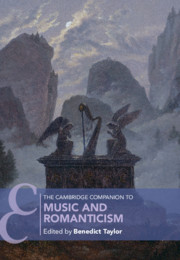‘We are accustomed to judge a thing by the title it bears’ wrote Robert Schumann concerning the music of his colleague, Hector Berlioz. Titles can indeed be important. This volume is intended as a ‘Companion to Music and Romanticism’ – not, it should be noted, to ‘Romantic Music’, or ‘Music in the Romantic Era’. Unlike many earlier books on the topic, Romanticism is not taken here primarily to refer to a distinct period in music history, though there is nevertheless a clear historical focus on the long nineteenth century, resulting from the overlapping between the Romantic period as generally understood in literature and art (c. 1797–1848) and as commonly received as a musical epoch (from c. 1815 to c. 1914). Nor, on the other hand, is Romanticism understood simply as a musical style, even one characteristic of a group of figures we might choose to term ‘Romantics’ (including, no doubt, Schumann and Berlioz). Rather, it is conceived as a constellation of themes, ideas, and responses rooted in the cultural milieu of post-Enlightenment, post-revolutionary Europe, which intersect with music in diverse and challenging ways.
Reflecting both the nature of the topic and the current diversity of disciplinary responses to these questions, the present volume is designed as a series of conceptual approaches that interrogate the relation between Romanticism and music from a range of different viewpoints: Horizons, Worlds, Aesthetics, Practices, and Histories. Written by a dynamic team of leading younger scholars and established authorities, it seeks to offer a state-of-the-art yet accessible overview of current thinking on this popular topic.
Romanticism is not the easiest topic to elucidate. But it does come with several ostensible advantages for an editor. A Companion clearly aims at a degree of comprehensiveness in coverage; just as evidently, it will never completely fulfil this demand. The advantage of treating a topic like Romanticism, however, is that such failure is not only expected, but singularly apt. I have tried to avoid obvious lacunae in topics covered; still, an unscrupulous editor has a convenient excuse to hand for any omissions by appealing to the aesthetics of incompletion and the Romantic fragment. Moreover, as Isaiah Berlin once argued, Romanticism marked an epochal change in the history of ideas in that two incompatible views could both be considered right in their own way. A range of viewpoints and approaches to the problem of framing Romanticism and music are given by the different contributors to this volume, not all of which may necessarily harmonise completely with one another (although there is in fact little significant disagreement between them). While some initial framework for the contributors was provided by the opening chapter, as I argue there, the tension between different understandings of Romanticism and its relationship with music – as a movement, historical period, style, or aesthetic – is one that authors will invariably negotiate for themselves. All the Companion’s contributors are experts in their field, and I have tried to allow their different voices to come across as clearly as possible, reflecting the topic under discussion and the perspective of the individual author.
Finally, some much-needed acknowledgements. I would like to offer a short but heartfelt thanks here to all those who helped and contributed to the making of this volume. In particular I must mention Kate Brett for initially commissioning this companion and seeing it through to publication, Elaine Kelly for valuable advice when putting it together, Damian Taylor for helpful comments on the sections I wrote, and last but by no means least, all nineteen contributors for their enormous expertise and enthusiasm for the subject.

